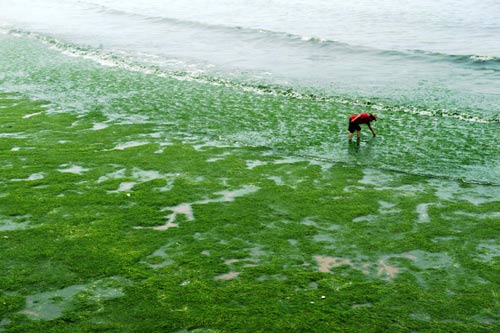Society
Green algae hits Qingdao beaches
By Wang Huazhong (China Dail)
Updated: 2010-07-03 09:09
 |
Large Medium Small |
 |
|
A tourist inspects the green algae sprawled on a beach in Qingdao on Tuesday. The rapidly growing sea grass is posing a threat to marine environment. [Li Ziheng / Xinhua] |
Popular coastal city fears sea grass may affect tourism as researchers scramble for reason
QINGDAO - An expanse of green algae sprawled over 440 square kilometers in the coastal city of Qingdao, Shandong province, remains an ecological threat, local marine forecasters said on Friday.
Though the plankton, namely enteromorpha prolifera, is not toxic, it blocks sunshine for marine life, experts said.
|
||||
The expanse has been proliferating since it was first reported.
From 330 sq km, the algae had spread over 12,400 sq km on the Yellow Sea as of June 23, according to official data.
Due to the wind and currents, the algae reached some islands and beaches south of Qingdao, blanketing its western coastline since June 28, the North China Sea Branch (NCSB) of the State Ocean Administration said.
"The city is besieged and the algae will keep affecting the region till the end of July", Huang Juan, director of forecasting center under the NCSB, told China Daily on Friday.
"Though enteromorpha is not edging closer today, it will hit more islands and beaches in Qingdao in the next two days," she said.
Huang said that Qingdao's Lingshan Bay, Tangdao Bay, Xuejia island, Tuandao island and Laoshantou would be affected by the algae by July 4.
Between 16 and 20 C is the ideal sea temperature for algae growth, said Pang Shaojun, a researcher from the Institute of Oceanology under the Chinese Academy of Sciences.
The air temperature in Qingdao has risen by 1 C per day on average over the past five days, reaching 27 C on Wednesday, the city's meteorological bureau said.
"The sea temperature has risen to 20 C today (Friday), and the algae will keep growing if the temperature continues to rise," Pang said.
The green algae did not catch the public eye until it started showing on the coast of Shandong province every summer since 2007, especially when it intruded the yacht training area and parts of the sailing routes of the 2008 Olympic Games.
Professor Bao Xianwen from the Qingdao-based Ocean University of China said research centers have yet to figure out the reason for the feverish growth of algae in recent years.
"We don't know where it originated and why it's suddenly growing so rapidly.
"It must have something to do with the change in the environment, but we are not scientifically sure about the reasons," Bao said.
He said the State Ocean Administration had initiated a project to study the phenomena and find a cure in 2009, but no progress has been made. "Most of what we can do is to predict drifting routes as accurately as possible for effective interception."
Over 6,000 people, including cleaning workers and sea police, were deployed to clean the green algae, as its continuing spread might affect the local fishery and tourism industries, said Ding Shugen from the Qingdao Committee of Municipal and Rural Construction.
The Qingdao Evening News reported that 400 locals had registered as volunteers to help clean up the beaches by Thursday. And 66 fishing boats, with a capacity of netting more than 1,000 tons of algae, had begun trawling since Tuesday.
Xinhua contributed to this story.



